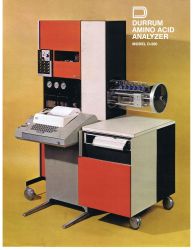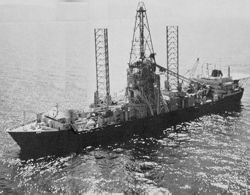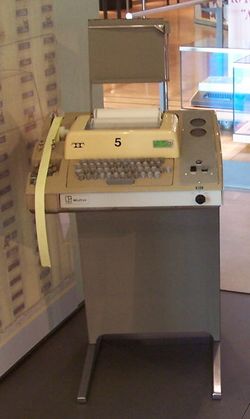Durrum D-500
and should NOT be used for any reason other than reading enjoyment |
The D-500 Amino acid Analyzer
How it worked
The D-500 Amino Acid Analyzer was designed and built by Durrum Instruments. At that time, Durrum was located on Fabian Way, Palo Alto, California, which was the spawning point of many high-tech companies.
The analysis process began with a technician processing a sample into liquid form. About one-half of a drop of sample is injected into a "holder" (filled with superfine resin beads made by Diamond-Shamrock), which was manually inserted into the analyzer.
The brains of the D-500 (a PDP-8 computer with a 1.5 MIPS speed / 650hertz clock) controlled an electrical pump with a piston made of synthetic ruby to control a very precise flow of hydraulic fluid to drive a "mechanical ram" assembly. This ram assembly had eight pistons/syringes (four on each side), each filled with a different pH liquid buffer. These buffers were then washed across the sample holder and into another resin bead-filled tube which had an inside diameter of about the diameter of a human hair.
Again, the PDP-8 was used to control the temperature of the separation tube. Since different amino acids have different gram-molecular weights and sizes, they were washed through the separation tube; much like different-sized objects move through beach sand at different speeds. At the bottom end of the separation tube, the effluent was mixed with ninhydrin, a chemical that changes color in the presence of ammonia, a component part of amino acids.
A colorimeter passes a precisely controlled wavelength light through a series of lenses and the effluent to a light sensor on the other side of the fluid stream. The output of the colorimeter was then fed back to the computer for processing. The computer would, besides sending a printout to the teletype, also drive a pen and ink recorder to create a visual graph.
Once the run (the time the sample was being analyzed, determined by the operator), the computer would then determine the time and the percentage of each amino acid present as they exited the separation tube.
As I said earlier, different molecules pass through the resin tube at various speeds, so by graphing the output of the colorimeter against time, it can be determined which amino acid is present. The amount of light passing through the colorimeter determined the "percentage of change from the baseline".
"The Magic"
Now here is where the "Magic" happens. The results of the analysis can be affected by:
- the volume of buffer flow (which changes the separation times between various amino acids - controlled by the speed of the ruby-piston pump) Flow is also affected by the inside diameter of the tube; the size of the resin beads, and how tightly they are packed inside the tube. Each separation tube had to be installed by a factory-trained tech, and days of testing and running baselines would begin all over again to recalibrate the analyzer.
- the size of the sample (controlled by the lab assistant preparing the sample)
- the temperature of the resin-bead tube (too high, the sample will be destroyed, too low the sample will not be separated)
- the volume of ninhydrin being added to the effluent
- the pH of the buffer being used to "wash" the sample through the resin-beads
- *The D-500 analyzer installed at Rockefeller University, NYC "died". When I arrived to "repair" it, I discovered that the dual-doctorate lab assistant had prepared (but failed to verify the pH) of the new set of buffers. It's always nice to catch "an expert" in error.)
- the original analyzer design began with calcium citrate washing buffer.
- When Lamont-Dougherty Labs began testing amino acids from seashells brought up from the ocean floor, the residue from the samples, when heated, became calcium carbonate (chalk) which clogged up the works. By changing to lithium citrate buffers, this problem was eliminated.
It was up to the person (or team) installing the analyzer to run it unceasingly for days to provide baseline computations. These baselines were used for future comparisons to ensure the machine was still operating correctly and to provide confidence in the calibration of future runs.
Hot and cold metal
The Durrum D-500 was a device the replaces electrophoresis as a way of measuring quantities of various amino acids in a solution. You can make your own, buy a pre-made system for about $300, or buy a complete, automatic analyzer for over $100k. The D-500 was in the last category... It was a combination of computer (a PDP-8), electro-mechanics, fluidics, optics, electronics, Ninhydrin colorimetry and quite a few other disciplines. Heaters were used to produce controlled 1200 degree temperatures measured in tenths of degrees. Pumps were so precise they used rubies for pistons producing 1400+ psi. Piping was the diameter of half a human hair.
Its "Achilles Heel" was, however, a stainless steel bar two-and-a-half inches in diameter and 36" long that was coupled to a one-inch thick stainless plate about eight inches square held in place by a quarter inch in diameter clevis pin (that pin that holds your trailer ball in place on your car). It is the same technology that holds the clutch pedal to the throw-out bear in sports cars, but ours were made to a much higher and tighter tolerance.
Every few months, this assembly would fail catastrophically, producing the sound of a small explosion. This would require a TechRep to travel to the clients' site and replace "The "Ram". Between waiting for a new part to be made, shipping, installation, and re-calibration, the analyzer would be down for days, if not weeks.
We developed a new "ingenious" way of manufacturing this part. We would drill the hole in the plate five ten-thousandths of an inch SMALLER than the bar. We froze the bar (making it smaller) and heated the plate (making it bigger). A team of four people would then assemble it. Two would hold the bar vertically, one would slide the plate onto the bar, and one would align the two pieces and push the clevis into place. The problem is you have one shot at this assembly process and less than thirty seconds. Once the bar and plate reached equal temperature, the plate literally fused itself into place with a strength measured in tons.
- Notes -
- This was all done on a computer with 4k of memory
- Eldex is still making precision pumps (These days, they are located in Napa, California)
What it did
The D-500 Amino-Acid analyzer was instrumental in
- developing a blood test for diagnosis of PKU (Phenylketonuria) in newborn infants
- determining genus and family of prehistoric shellfish by studying the genetic makeup of samples brought up from the ocean floor by the "Glomar Explorer" and "Glomar Challenger" of Howard Hughes fame.
- Study of diamino-carbon analogs in Vasotocin.
- Molecular Cloning and Expression in Different Microbes of the DNA Encoding Pseudomonas putida to improve the rate of benzylpenicillin biosynthesis.
- Study of the Substrate of Avian Myeloblastosis Virus Proteinase and Lentiviral Proteinases
- Mammalian growth factors, and in particular to heparin-binding growth factors
The PDP-8 Computer
- The manufacturer was Digital Equipment Corporation (DEC) - who opted for the name DEC because they were afraid that calling their company "Digital Computer Corporation" might be
- limiting the scope of their company, and
- the word "computer" in the company name might scare off potential investors
- "PDP" stands for "Programmable Digital Processor", again to avoid the word "computer."
- The PDP-8 computers used by the D-500 were the PDP-8L and PDP-8M versions
- Just under 50,000 computers were sold worldwide
- The PDP-8 processor speed was a "Blindingly fast" 1.0 MHz (It is not unusual to find home PC's running at 3.2 GHz - 3,200 times the speed)
- The PDP-8L and PDP-8M had no integrated circuits (ICs) - it was "all about" discrete transistors, resistors, capacitors, etc. And, yes, it was possible to change the programming by using a soldering iron! <G>
- The PDP-8 had 4k memory
- One "PDP-8 Emulator" program for Windows is just over 1.5MB and wouldn't fit on a 3 1/2" floppy disk (My cellphone has a 512MB flash memory card!)
- One of today's CDs would hold 3,200 times the total memory of ALL the nearly 50,000 PDP-8's sold around the world.
- Base price was about $18,000 each, plus the cost of the AN/ASR-33 or -35 Teletypewriter (TTY), which could cost as much as $4,000 (about 32 times the price of one of today's laptops)
- being an electro-mechanical device, the ASR-35 had a top speed of 55 words per minute
- had a "top input/output (I/O) speed" of 110 baud. (Today, most cable networks runs at 100MB/second)
The "FAQ" for PDP-8 is at http://www.faqs.org/faqs/dec-faq/pdp8/
MODEL DATE PRICE BITS NUMBER COMMENTS
===== ==== ======== ==== ====== ========
PDP-1 1960 $120,000 18 50 DEC's first computer
PDP-2 NA 24 - Never built? Prototype only?
PDP-3 NA 36 One built by a customer*, not by DEC.
PDP-4 1962 $60,000 18 45 Predecessor of the PDP-7.
PDP-5 1963 $27,000 12 1,000 The ancestor of the PDP-8.
PDP-6 1964 $300,000 36 23 A big computer; 23 built, most for MIT.
PDP-7 1965 $72,000 18 120 Widely used for real-time control.
PDP-8 1965 $18,500 12 ~50,000 The smallest and least expensive PDP.
PDP-9 1966 $35,000 18 445 An upgrade of the PDP-7.
PDP-10 1967 $110,000 36 **~700 A PDP-6 followup, great for timesharing.
PDP-11 1970 $10,800 16 >600,000 DEC's first and only 16 bit computer.
PDP-12 1969 $27,900 12 725 A PDP-8 relative.
PDP-13 NA - Bad luck. There was no such machine.
PDP-14 *** A ROM-based programmable controller.
PDP-15 1970 $16,500 18 790 A TTL upgrade of the PDP-9.
PDP-16 1972 NA 8/16 ? A register-transfer module system.
It must be remembered that the PDP series of "programmable digital processors" had no keyboard or computer screen. Data storage, both in and out, was done using paper tape with holes punched in it. One inch of It used a pen and ink scrolling printer should display its output.
| This page may use content from Wikipedia. The original article was at Durrum D-500. The list of authors can be seen in the page history. |
See also [ @Durrum ] for personal stories about my time at Durrum
What links here • References and Sources • Help • Contact info • Category:Root ⤴


